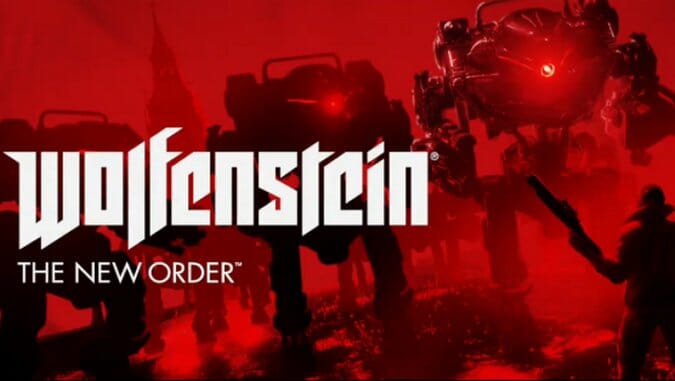Wolfenstein: The New Order (Multi-Platform)

The Nazis keep winning World War II. They beat the Allies in books, plays, TV shows, comics and any medium that can support a story. Noël Coward, Phillip K. Dick and Newt Gingrich all wrote the Nazis to victory. A time-displaced “Bones” McCoy saved the life of a woman who goes on to inadvertently help the Nazis win the war. Alternate timelines with Nazi victories are as common in fiction as misunderstood monsters romancing innocent young women, and with Wolfenstein: The New Order we have yet another videogame that plays with the idea.
The New Order’s speculative fiction is on the less plausible end of the spectrum. The Germans win the war with robots of various shapes and sizes. They have robot dogs, the robot from the beginning of Robocop, massive robots as big as mountains that can rain instant death down upon their enemies, and (most annoyingly of all) tiny robot drones that quickly dart about the screen while peppering my stalwart hero with machine gun spray. The New Order doesn’t come about due to American reluctance or an effective fifth column. The Nazis win the war with remote control helicopters.
The New Order embraces its status as a B-movie. Like 2010’s Singularity, The New Order takes its patently ridiculous post-World War II sci-fi story seriously. War isn’t presented as a fun adventure. The hidden enclave of resistance fighters are suitably downtrodden and depressed. Its Nazis are ghoulish but not cartoonish or precious—they’re as faceless as their robots, the logical extension of the Reich’s banal evil. It’s not humorless, but it’s not cloying or tongue-in-cheek, and that commitment is admirable.
It’s also not the interminable run’n’gun shooter that the name evokes. Many games claim to welcome both frontal assaults and stealthier play, depending on my tastes. Few effectively deliver on that promise. The New Order mostly threads that needle. It’s a first-person shooter, so obviously there are moments when throngs of Nazis must be dealt with exclusively through gunfire, but a surprisingly large part of the game is navigable through quiet slinking and swift backstab assassinations.
The game regularly punishes me for not sneaking around—there’s an enemy type called the Commander that immediately calls in backup troops when alerted to my presence, clogging these bunkers and laboratories with deadly Nazis. It’s effective punishment in that I don’t want to get bogged down in lengthy shootouts, but gunning my way out of a bad situation is as satisfying on a mechanical level as sneaking about, so I guess I win either way.
The New Order is a capable shooter when it doesn’t give me time to think, but there’s a crucial hole at the center of the game. William “B.J.” Blazkowicz is still nothing more than a stock action hero. He’s Channing Tatum crossed with a John Cena action figure. He has no flaws, no personality and, despite regularly voicing his thoughts, no interior life. He’s a walking gun who can’t stop muttering the most obvious observations to himself. That’s expected, though. This is a Wolfenstein game, typically not the home of memorable or well-defined characters.
It’s also the first game from Machine Games, though. Machine Games was started by a group of designers who used to work for Starbreeze, the Swedish developer behind the Riddick games and the first Darkness. They have a history of subverting expectations with games based on licensed properties, finding unusual depth and emotion within shooters derived from bad comics and sci-fi movies.
-

-

-

-

-

-

-

-

-

-

-

-

-

-

-

-

-

-

-

-

-

-

-

-

-

-

-

-

-

-

-

-

-

-

-

-

-

-

-

-









































